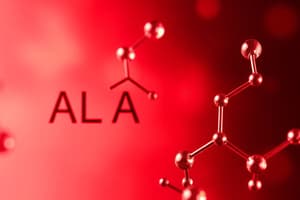Podcast
Questions and Answers
What is the general formula for alkanes, where n is the number of carbon atoms?
What is the general formula for alkanes, where n is the number of carbon atoms?
- CnH2n
- CnHn
- CnH2n-2
- CnH2n+2 (correct)
What is a common use of methane (CH4)?
What is a common use of methane (CH4)?
- Primary component of natural gas (correct)
- Production of plastics
- Lubricant
- Fuel for grills
What is the reason for the increase in boiling points of alkanes with molecular weight?
What is the reason for the increase in boiling points of alkanes with molecular weight?
- Decrease in molecular weight
- Presence of functional groups
- Weaker intermolecular forces
- Stronger intermolecular forces (correct)
What is the process of breaking down larger alkanes into smaller ones?
What is the process of breaking down larger alkanes into smaller ones?
What is the purpose of IUPAC rules in naming alkanes?
What is the purpose of IUPAC rules in naming alkanes?
What is a common property of alkanes?
What is a common property of alkanes?
What is the process of rearranging the molecular structure of an alkane to form a different isomer?
What is the process of rearranging the molecular structure of an alkane to form a different isomer?
What is the suffix added to the longest continuous chain of carbon atoms in naming alkanes?
What is the suffix added to the longest continuous chain of carbon atoms in naming alkanes?
Study Notes
Definition and Structure
- Alkanes are a type of saturated hydrocarbon, meaning they contain only single bonds between carbon atoms.
- General formula: CnH2n+2, where n is the number of carbon atoms.
- Also known as paraffins or saturated hydrocarbons.
Physical Properties
- Alkanes are colorless, odorless, and non-polar.
- They are insoluble in water, but soluble in non-polar solvents like hexane.
- Boiling points increase with molecular weight, as larger molecules have stronger intermolecular forces.
- Melting points also increase with molecular weight, but not as steadily as boiling points.
Chemical Properties
- Alkanes are relatively unreactive, but can undergo combustion reactions with oxygen.
- They can also undergo substitution reactions, where a hydrogen atom is replaced by a functional group.
- Cracking: breaking down larger alkanes into smaller ones, often used in petroleum refining.
- Isomerization: rearranging the molecular structure of an alkane to form a different isomer.
Nomenclature
- IUPAC rules are used to name alkanes.
- The longest continuous chain of carbon atoms is identified, and the suffix "-ane" is added.
- Branching chains are named as substituents, using the prefix "alk-" and the number of carbon atoms in the branch.
- Compounds with functional groups are named using the parent alkane chain and a prefix or suffix indicating the functional group.
Examples and Uses
- Methane (CH4): primary component of natural gas, used as a fuel.
- Ethane (C2H6): used as a fuel and in the production of plastics.
- Propane (C3H8): used as a fuel for grills and vehicles.
- Butane (C4H10): used as a fuel, in lighters, and in the production of plastics.
- Alkanes are also used as lubricants, in cosmetics, and as solvents.
Definition and Structure
- Alkanes are saturated hydrocarbons with single bonds between carbon atoms.
- General formula: CnH2n+2, where n is the number of carbon atoms.
- Also known as paraffins or saturated hydrocarbons.
Physical Properties
- Alkanes are colorless, odorless, and non-polar.
- Insoluble in water, but soluble in non-polar solvents like hexane.
- Boiling points increase with molecular weight due to stronger intermolecular forces.
- Melting points increase with molecular weight, but not as steadily as boiling points.
Chemical Properties
- Alkanes are relatively unreactive, but undergo combustion reactions with oxygen.
- Can undergo substitution reactions, replacing a hydrogen atom with a functional group.
- Cracking: breaking down larger alkanes into smaller ones, used in petroleum refining.
- Isomerization: rearranging the molecular structure to form a different isomer.
Nomenclature
- IUPAC rules are used to name alkanes.
- Identify the longest continuous carbon chain, and add the suffix "-ane".
- Branching chains are named as substituents using the prefix "alk-" and the number of carbon atoms.
- Functional groups are indicated by a prefix or suffix on the parent alkane chain.
Examples and Uses
- Methane (CH4): primary component of natural gas, used as a fuel.
- Ethane (C2H6): used as a fuel and in plastic production.
- Propane (C3H8): used as a fuel for grills and vehicles.
- Butane (C4H10): used as a fuel, in lighters, and in plastic production.
- Alkanes are also used as lubricants, in cosmetics, and as solvents.
Studying That Suits You
Use AI to generate personalized quizzes and flashcards to suit your learning preferences.
Description
This quiz covers the definition, structure, and physical properties of alkanes, a type of saturated hydrocarbon.



